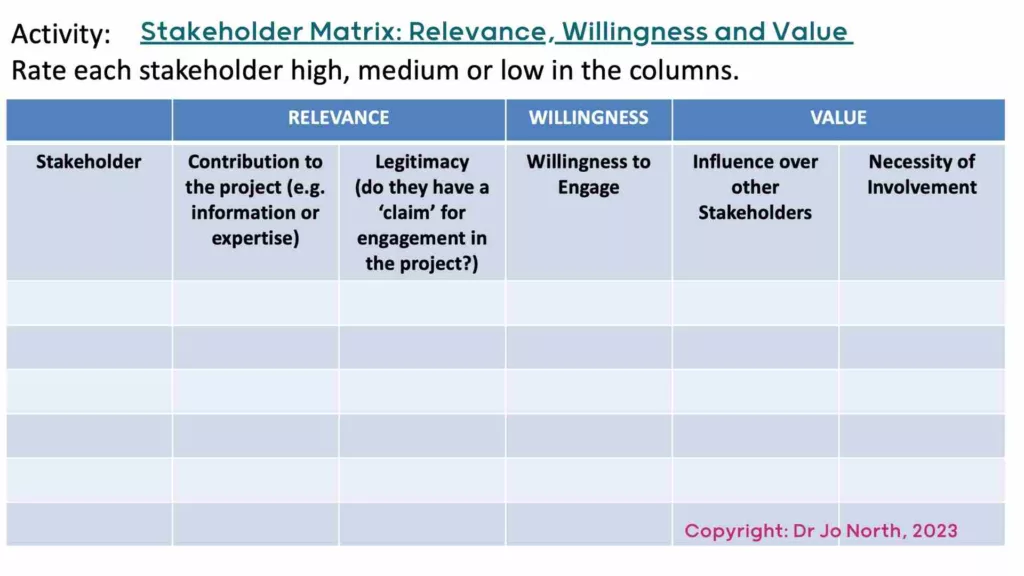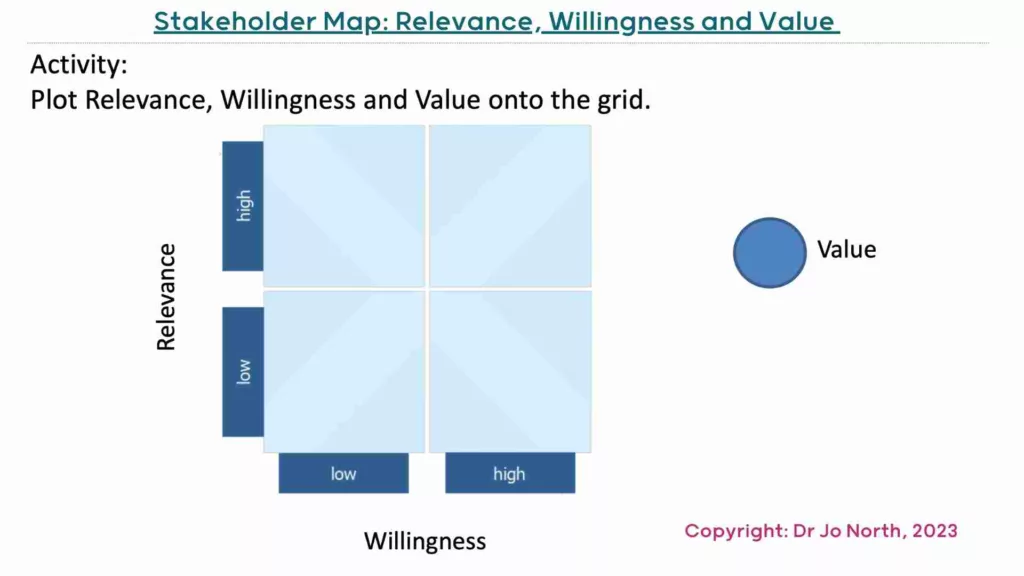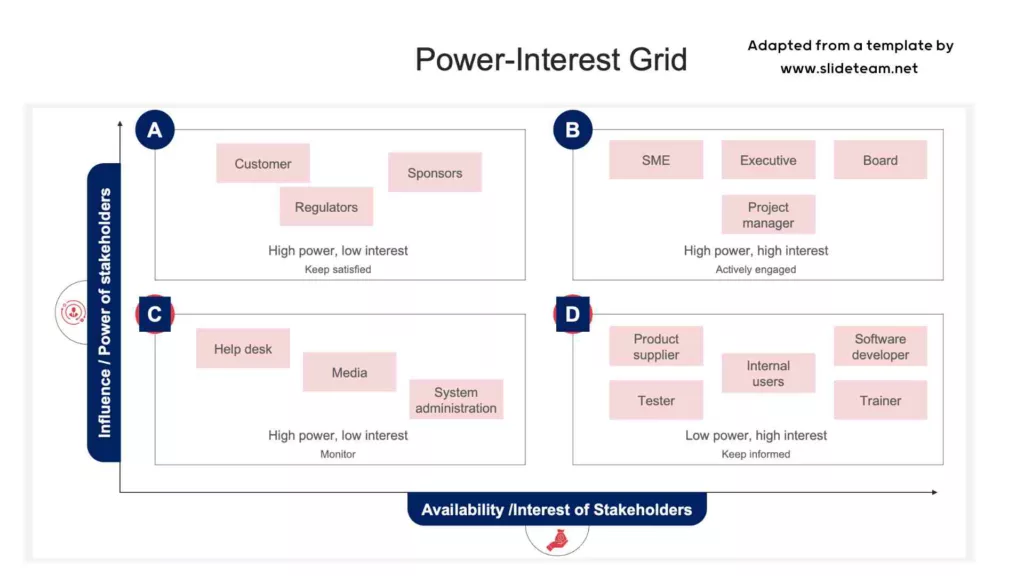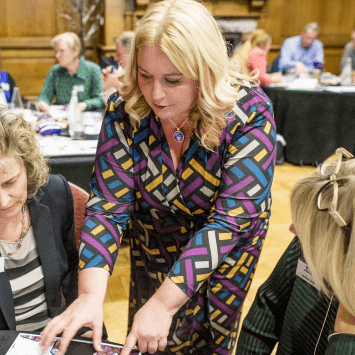Posted in Blog, Facilitation, Influencing people, Meetings, Virtual Facilitation by Jo North
Stakeholder Mapping: Your Guide to Facilitating a Successful Workshop
Stakeholder mapping is an essential tool for any project manager spearheading innovation or undertaking significant projects. At the heart of successful project management lies the ability to understand and engage with the key players who can influence the outcome. Whether you’re on the brink of launching a new product or embarking on a transformative initiative, the first step is always to know who these individuals or entities are, and what stakes they hold.
But how do you collaboratively identify both internal and external stakeholders, deciphering their level of interest and the extent of their influence? That’s where a stakeholder mapping workshop comes into play. This participatory exercise is the best way for project team members to come together, pool their knowledge, and create a holistic view of all project stakeholders.
This article offers a step-by-step guide on how to facilitate a successful stakeholder mapping workshop, complete with a suggested agenda and useful templates. From using virtual or physical sticky notes to visualize and categorize stakeholders based on their level of involvement to advanced stakeholder mapping tools that help refine the stakeholder engagement strategy, you’ll be equipped with everything you need.
So, whether you’re new to stakeholder mapping or simply looking for a refresher, let’s dive into a process that promises to set your project on a path of clarity and positive stakeholder engagement.
What is a stakeholder?
A stakeholder is an individual, group or organisation who is impacted by the outcome of a project.
They have an interest in the success of the project, and can be within or outside the organization that is sponsoring the project.
Stakeholders can have a positive or negative influence on the project.
The Stakeholder Mapping Process
Stakeholder mapping is a process designed to determine a key list of stakeholders.
Mapping can be broken down into four phases:
1. Identifying: listing relevant groups, organizations, and people.
2. Mapping: visualising relationships to objectives and other stakeholders.
3. Prioritizing: ranking stakeholder relevance and identifying issues.
4. Planning your approach.
Preparation and Pre-Work for Your Stakeholder Mapping Workshop
You might want to brief your delegates to do some pre-work to bring along to the session. This way, they will come along informed, saving time during the workshop and improving the quality of discussions. Here are some pre-work suggestions:
- Review existing documentation: Extract names and entities from project plans, organizational charts, and other relevant documents.
- Stakeholder interviews: Engage in one-on-one discussions with representative stakeholders to gain insights.
- Surveys: Send out questionnaires to a broader stakeholder group to gather quantitative and qualitative data.
These activities are not essential, but could be very helpful, if you have sufficient notice and time before the workshop date.
Step 1: Introducing the Stakeholder Mapping Workshop and Preparing Delegates for Participation
To ensure a good start to the stakeholder mapping workshop, it’s vital to set the stage correctly. As the facilitator, your primary task in this critical step is to clarify the session’s purpose and its importance in shaping the communication strategy for the outcome of your project.
Begin by explaining that stakeholder mapping is not just a formality but an important process to comprehend the diverse stakeholder’s interests. Highlight that understanding these interests is paramount, as they can either propel the project to success or have a negative impact if not adequately addressed.
Share with the participants that the aim is to identify various parties connected to the project, their stakes, and how to best communicate and engage with them. Emphasize that by doing so, the project team can ensure that all involved parties feel valued, heard, and integrated into the project’s journey.
Warm-up Activities
Here are some suggested warm-up activities.
Stakeholder Bingo: Create a bingo card filled with phrases or characteristics that might relate to potential stakeholders (e.g., “Has a financial interest,” “External party,” “Can veto decisions”). As participants introduce themselves, attendees mark off any relevant boxes. The first to complete a row or column shouts “Bingo!” This activity introduces the idea of varying stakeholder interests and categories.
Expectation Wall: Provide each participant with sticky notes and ask them to write down what they expect from the workshop. Collect and stick these on a wall. This activity gives insight into the participants’ expectations and allows you to address any misconceptions or align the session accordingly.
By the end of this introductory step, participants should feel warmed up, engaged, and ready to delve deep into the subsequent phases of stakeholder mapping.
You’ll find even more suggestions in my article on icebreakers and warm-ups here.
Step 2: Identifying and Listing Relevant Groups, Organizations, and People
At this foundational stage, the goal is to create an exhaustive list of everyone who has a stake in your project. This could range from internal team members to external organizations, community groups, and individuals. Ideally, separate internal and external stakeholders as you work through this activity.
It will be useful to ask your participants to work in smaller breakout groups. Each group could perhaps work on a different stakeholder group or category. For instance: political, community, media, suppliers etc. make sure that the teams write the name of each individual or organizational stakeholder onto a separate virtual or paper sticky note.
Brief your delegates as follows:
On individual sticky notes, write down the names of each of your stakeholders without screening, critiquing or sorting. Include everyone who would like to be involved in or affected by your innovation or project, and everyone who you would like to involve. Where possible, identify individuals / names of roles, rather than organizations.
Just to be super clear, at the end of the activity, your participants should have a virtual or real pile of sticky notes. Each sticky note has only one stakeholder written on it. This is important to set your teams up for the next step.
Step 3: Stakeholder Mapping and Analysis
Stakeholder mapping and analysis helps to visualize the relationship of each of the stakeholders to the project. Here are some activity options that you can either choose from or combine for your workshop. You can of course change any of the words or ‘labels’ to suit your needs.
Option 1: Stakeholder Relevance, Willingness and Value Matrix
I created the stakeholder relevance, willingness and value matrix to prompt delegates to engage in deeper thought, discussion and analysis.
Create the stakeholder matrix template below as a giant canvas, perhaps printed on a large ‘plotter’ machine, on a virtual or real whiteboard, or with a few flip chart pages stuck side by side.

Ask your delegates to move their sticky notes into the first column, and then, through discussion, work their way from left to right to complete all the columns:
- Relevance, divided into:
- Contribution to the project (e.g. information or expertise)
- Legitimacy (i.e., does the stakeholder have a ‘claim’ for engagement in the project?
- Willingness to engage with project
- Value, divided into:
- Influence over other stakeholders
- Necessity of involvement
Make sure they write down any their key points and observations onto the stakeholder mapping template as they go. They should also score each stakeholder High, Medium or Low in each column.
Your delegates could get absorbed, or even stuck, in their discussions on particular stakeholders. Make sure that they don’t debate every single thing at length, or you won’t achieve much in your session. Keep it moving and high level. It’s the overall shape and picture that matters at this stage, not the fine detail. That can come later.
Option 2: Stakeholder Relevance, Willingness and Value Map
You could either facilitate the Stakeholder Relevance, Willingness and Value Map after your delegates have completed the matrix in option 1 above. Or, you could go straight to it as a standalone activity.

Delegates can transfer their sticky notes from step 2 (if you’ve NOT asked them to complete the matrix in Step 2 above) to the stakeholder map template over. Or, simply write in the stakeholder names (if you HAVE asked them to complete the Step 2 matrix). Obviously, you’ll want to keep the sticky notes on the matrix so you have a record of which stakeholders the content is about!
Ask delegates to plot each stakeholder onto the map, based on how high or low they perceive the stakeholder’s willingness to engage and support (horizontal axis) and relevance (vertical axis). Participants should then put a circle around the stakeholder’s name on the map to represent the amount of value they bring. A small circle for not much, a very large one for a great deal of value.
As above, value is defined by a combination of:
- Influence over other stakeholders
- Necessity of involvement
This creates a really useful visualization of the stakeholder population.
Option 3: Power-Interest Grid
The Power-Interest Grid works as a great, quick standalone activity to help your delegates to sort and visualize their stakeholders. Using the grid as a template on a flip chart, virtual or real whiteboard, ask them to take their sticky notes from Step 2 and plot them onto the grid.

Step 4. Prioritizing Stakeholders
Not all stakeholders are equal in terms of their influence and interest. It’s crucial to determine which stakeholders can significantly impact the project’s success or failure.
It is not practical and usually not necessary to engage with all stakeholder groups with the same level of intensity all of the time.
Being strategic and clear about whom you are engaging with and why, before jumping in, can help save your project team time and effort.
Brief your delegates to create a summary of their top 10 or so priority stakeholders, capturing responses to these questions:
- Who are your priority stakeholders?
- What issues / interests do they have?
- How do your stakeholders’ interests match or differ from your project objectives?
Step 5. Planning Your Approach
With a clear understanding of who the stakeholders are, their interests, relationships, and potential issues, it’s time for your participants to strategize on how to engage with them effectively.
Communication Strategy Discussion
Using the prioritized stakeholders from Step 4, the project team should brainstorm tailored communication strategies for each category. This requires thinking about the needs, interests, and preferences of each stakeholder group.
Collaborative Refinement
After each group has had an opportunity to devise communication strategies, bring everyone together to discuss and refine these ideas. Real-world experiences from team members can be invaluable in this stage, highlighting potential pitfalls or areas of improvement.
Action Planning
With communication strategies in place, ask the groups to find volunteers for tasks such as drafting communication templates, scheduling stakeholder meetings, and overseeing any necessary public outreach efforts.
Project team members will be empowered to not only understand their stakeholder landscape but also to devise actionable, tailored communication strategies, ensuring the smooth progression of their innovation project.
Next Steps
By following these four phases methodically, project teams can ensure that they’ve covered all their bases when it comes to stakeholder management. This not only minimizes potential roadblocks but also leverages stakeholder expertise and insights, enhancing the project’s chances of success.
Stakeholder mapping, while intricate, plays a pivotal role in the journey of any project. It’s more than just recognizing the key players; it’s about cultivating relationships, understanding diverse interests, and devising actionable strategies to engage effectively with every stakeholder. While this guide provides a structured approach to stakeholder mapping, the true magic lies in the collaborative energies, insights, and expertise each team member brings to the table.
Use Stakeholder Mapping Tools for Better Understanding and Action
Stakeholder mapping, an important tool in the arsenal of any project manager, goes beyond the mere identification of key stakeholders; it delves deep into understanding their level of influence, from high interest to low interest, in the overarching design process.
Through stakeholder mapping templates and the right stakeholder mapping tool, teams can sift through the vast amount of information to identify which types of stakeholders hold much influence and discern each stakeholder’s level of engagement.
Whether you’re venturing into a new market or embarking on a large project like a construction project, grasping the relative importance of each stakeholder, from those with high influence to those with vested interest, is essential.
The stakeholder mapping exercise is not just a visual tool but a powerful tool that aids in crafting effective stakeholder management strategies, from phone calls to more intricate product roadmaps tailored to stakeholder needs.
Larger organizations often find themselves navigating a sea of potential impact areas, where understanding the specific needs of each stakeholder, from the project sponsor to examples of internal stakeholders, is paramount. By employing a good stakeholder map, you create a visual representation of the relevant stakeholders, ensuring that important stakeholders aren’t overshadowed by those with a louder voice or higher degree of influence.
Ensure Great Communications
From the power interest grid to other stakeholder mapping models, there are different ways to map stakeholders. Each offers a unique perspective, helping to chart out effective communication plans for better outcomes. For instance, a new project might introduce new stakeholders, altering the dynamics of your company’s stakeholders.
Ensuring good communications, through methods like phone calls or more advanced stakeholder engagement plans, can make a significant difference in the success of your project.
This thorough stakeholder analysis ensures that no vital information slips through the cracks. Whether you’re focusing on the global community or your own stakeholder map, the final step is always to ensure that the stakeholder engagement plan aligns with the issue areas, ensuring every voice, from the loudest to those often overlooked, is heard and valued.
Keep Your Stakeholder Map Up-to-date
As projects evolve and new challenges arise, so too will the stakeholder landscape. Keeping your stakeholder map updated and revisiting your engagement strategies will be essential. Remember, the end goal isn’t just the completion of a project but fostering a cohesive environment where every stakeholder feels valued and invested.
Connect for Challenging or Complex Stakeholder Landscapes
If facilitating a workshop or addressing stakeholder mapping seems daunting or if you simply wish to enhance your existing strategies, remember that you’re not alone on this journey.
Whether you’re seeking advice, hands-on assistance, or simply a conversation to share perspectives, I’m here to help. Navigating the waters of stakeholder engagement requires tact, experience, and sometimes, an external perspective.
Feel free to reach out here to discuss your facilitation needs or any other queries you might have. Together, let’s set the stage for successful, collaborative, and impactful project outcomes.


